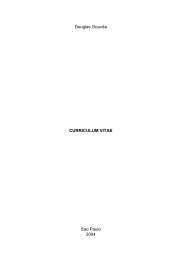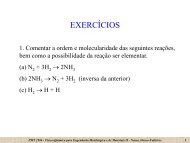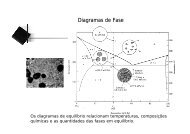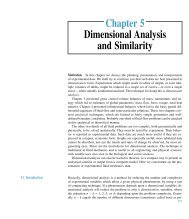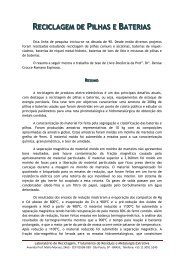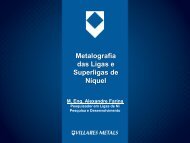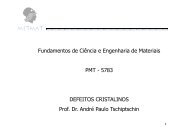Macrosegregation of Impurities in Directionally Solidified Silicon
Macrosegregation of Impurities in Directionally Solidified Silicon
Macrosegregation of Impurities in Directionally Solidified Silicon
Create successful ePaper yourself
Turn your PDF publications into a flip-book with our unique Google optimized e-Paper software.
~7.1 9 10 5 Pa (0.7 atm), which was ma<strong>in</strong>ta<strong>in</strong>ed until the<br />
end <strong>of</strong> each experiment. The high-purity argon was<br />
<strong>in</strong>jected to m<strong>in</strong>imize the formation <strong>of</strong> gaseous SiO by<br />
chemical reaction between the silicon melt and quartz<br />
tube.<br />
To stabilize the solidification system thermally, after<br />
pour<strong>in</strong>g the melt <strong>in</strong>to the quartz mold, the furnace was<br />
ma<strong>in</strong>ta<strong>in</strong>ed for 45 m<strong>in</strong>utes at a temperature <strong>of</strong> 1773 K<br />
(1500 °C), controlled by a type-B thermocouple (Pt-<br />
6 pct Rh / Pt-30 pct Rh) positioned between the zircon<br />
shell and the graphite susceptor and fixed at the furnace<br />
(Figure 1(b)). This thermocouple was <strong>in</strong>serted <strong>in</strong>to a<br />
completely sealed alum<strong>in</strong>a sheath for protection aga<strong>in</strong>st<br />
the furnace environment. After stabilization, the mold<br />
began to move down, out <strong>of</strong> the graphite susceptor, at a<br />
controlled velocity. On leav<strong>in</strong>g the susceptor, the mold<br />
crossed a graphite baffle designed to separate the hot<br />
and cold zones <strong>of</strong> the furnace. The cold zone was formed<br />
by a water-cooled serpent<strong>in</strong>e.<br />
In one <strong>of</strong> the experiments, two type-B thermocouples<br />
sheathed by closed end quartz tubes (<strong>in</strong>ner diameter<br />
5.2 mm, outer diameter 6.7 mm) were located parallel<br />
to the quartz mold tube, adjacent to the tube outer<br />
surface (Figure 1(b)). These thermocouples, which<br />
moved down with the mold, were connected to a data<br />
acquisition system to convert the electric signals <strong>in</strong>to<br />
temperature, enabl<strong>in</strong>g the calculation <strong>of</strong> a temperature<br />
gradient at the tube outer surface. This gradient was<br />
considered as a good estimate <strong>of</strong> the temperature<br />
gradient with<strong>in</strong> the mold. The measured temperature<br />
gradient (G) varied between 10 and 20 K cm –1 <strong>in</strong> the<br />
temperature range between 1573 K (1300 °C) and<br />
1687 K (1414 °C), at the mold velocity <strong>of</strong> 10 lm<br />
seconds –1 . The current experiments were designed to<br />
assess the effect <strong>of</strong> the withdrawal velocity <strong>of</strong> the mold<br />
from the furnace (5 £ V £ 110 lm seconds –1 ), which is<br />
related directly to the solidification velocity, on the<br />
macrosegregation <strong>of</strong> impurities <strong>in</strong> the directionally<br />
solidified Si <strong>in</strong>gots.<br />
III. PREPARATION AND CHEMICAL<br />
ANALYSES OF SAMPLES<br />
After solidification and cool<strong>in</strong>g to room temperature,<br />
each Si cyl<strong>in</strong>drical <strong>in</strong>got (length 0.25 m, diameter<br />
0.034 m) was stripped out <strong>of</strong> the quartz mold and<br />
sectioned transversally <strong>in</strong> at most 10 slices <strong>of</strong> approximately<br />
equal thickness. These slices were then sectioned<br />
longitud<strong>in</strong>ally, giv<strong>in</strong>g rise to two halves: one for<br />
chemical analysis and the other for microstructural<br />
and macrostructural exam<strong>in</strong>ation. The half for chemical<br />
analysis (~100 g) was shattered, and enough pieces were<br />
collected to create three samples <strong>of</strong> 3 g. Each sample<br />
was dissolved <strong>in</strong> a solution consist<strong>in</strong>g <strong>of</strong> 5-mL HNO 3<br />
(65 pct P.A.) and 15-mL HF (48 pct P.A.) and then<br />
analyzed by <strong>in</strong>ductively coupled plasma atomic emission<br />
spectroscopy (ICP) <strong>in</strong> a Shimadzu ICPS-7500 system.<br />
The average <strong>of</strong> the concentration values for the three<br />
samples, represent<strong>in</strong>g about 5 pct <strong>of</strong> the whole slice<br />
mass, was adopted as the slice composition.<br />
A quantification limit (QL) was estimated for each<br />
impurity by analyz<strong>in</strong>g a series <strong>of</strong> standard solutions with<br />
decreas<strong>in</strong>g concentrations. In the series, the measured<br />
concentration <strong>of</strong> each impurity decreased to an approximately<br />
constant value, no longer chang<strong>in</strong>g significantly<br />
for solutions <strong>of</strong> lower concentrations. This constant<br />
value was actually the blank concentration with a<br />
superimposed background noise. The QL given <strong>in</strong><br />
Table II was def<strong>in</strong>ed as three times this constant<br />
concentration value. The standard deviation <strong>of</strong> the<br />
blank concentration was used also to calculate the<br />
quantification limit recommended by the International<br />
Union <strong>of</strong> Pure and Applied Chemistry, [38] but this limit<br />
was always lower than the QL presented <strong>in</strong> Table II,<br />
which was f<strong>in</strong>ally adopted <strong>in</strong> an attempt to improve the<br />
quantification methodology carried out <strong>in</strong> the current<br />
work.<br />
As will be shown subsequently, <strong>in</strong> some <strong>of</strong> the <strong>in</strong>gots,<br />
most slices have concentration values for some impurities<br />
that are below their QL. When for a given impurity,<br />
the <strong>in</strong>got had at least 90 pct <strong>of</strong> its slices with concentrations<br />
above the QL, these values were used to<br />
calculate an average concentration (C av ) for the impurity.<br />
The C av value is compared with the composition <strong>of</strong><br />
the start<strong>in</strong>g MG-Si (C 0 ) <strong>in</strong> Table II, show<strong>in</strong>g reasonable<br />
agreement for most impurities. When there is segregation<br />
<strong>of</strong> impurities with<strong>in</strong> one slice (e.g., lateral segregation<br />
[39] ), an important source <strong>of</strong> discrepancy between<br />
C av and C 0 could be the small portion <strong>of</strong> the slice (5 pct<br />
<strong>of</strong> the slice mass) be<strong>in</strong>g analyzed. Another source might<br />
be the limited number <strong>of</strong> slices with concentrations<br />
above the QL for certa<strong>in</strong> impurities. For example, <strong>in</strong> the<br />
case <strong>of</strong> V, Ni, and Zr, slices from only one <strong>in</strong>got<br />
(V = 110 lm seconds –1 ) were taken <strong>in</strong>to account to<br />
calculate C av .<br />
To calculate C av for Al, all the four <strong>in</strong>gots obta<strong>in</strong>ed <strong>in</strong><br />
the experiments were considered. Nevertheless, a large<br />
discrepancy is still observed between C av and C 0 . A<br />
possible explanation is the oxidation <strong>of</strong> Al dur<strong>in</strong>g<br />
melt<strong>in</strong>g <strong>in</strong> the melt<strong>in</strong>g chamber <strong>of</strong> the Bridgman furnace<br />
(Figure 1(a)), decreas<strong>in</strong>g the average Al content from C 0<br />
(<strong>in</strong> the MG-Si) to C av <strong>in</strong> the <strong>in</strong>gots. This preferential<br />
oxidation <strong>of</strong> Al, which is sometimes used to remove it<br />
from molten Si by oxygen <strong>in</strong>jection, [40] can occur <strong>in</strong> the<br />
contact between the melt and a top slag naturally<br />
formed from the SiO 2 and other oxides already present<br />
<strong>in</strong> the MG-Si used as the start<strong>in</strong>g material. Another<br />
source <strong>of</strong> oxidation is the wall <strong>of</strong> the quartz crucible<br />
located <strong>in</strong> the furnace melt<strong>in</strong>g chamber. For thermodynamic<br />
reasons, this oxidation should be even more<br />
<strong>in</strong>tense for Na and Ca; furthermore, these elements are<br />
volatile and could evaporate both <strong>in</strong> the melt<strong>in</strong>g and<br />
solidification chambers <strong>of</strong> the furnace, possibly affect<strong>in</strong>g<br />
their macrosegregation <strong>in</strong> the <strong>in</strong>gots. Therefore, these<br />
two elements were not analyzed along the result<strong>in</strong>g<br />
<strong>in</strong>gots.<br />
The glow discharge mass spectrometry technique<br />
(GDMS) was used also for chemical analysis <strong>of</strong> an area<br />
approximately 18 mm 2 on the surface <strong>of</strong> slices cut from<br />
the bottom <strong>of</strong> some <strong>of</strong> the <strong>in</strong>gots, near the center <strong>of</strong> their<br />
transversal section. Note that the GDMS analyses give<br />
METALLURGICAL AND MATERIALS TRANSACTIONS A VOLUME 42A, JULY 2011—1873


